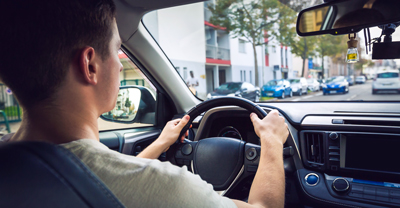What is defensive driving?


0 min. read
What does defensive driving mean? Ever slam on your brakes when someone cuts you off? Or tense up, gripping the steering wheel tighter, when a car drifts too close to your lane? Those aren't just reactions—they're instincts. And they signal how important it is to stay alert behind the wheel.
According to the National Highway Traffic Safety Administration, an estimated 42,795 people died in motor vehicle crashes in 2022—underscoring the continued importance of defensive driving to help prevent accidents and save lives.*
Defensive drivers don't just react—they anticipate. The habits below can help you stay focused, adjust to conditions, and keep a safe buffer between you and the unexpected.

See your insurance options—start a free auto insurance quote today.
Smart defensive driving habits
Learning to drive defensively can help reduce your crash risk—whether you're just starting out or have years of experience. And practicing defensive driving doesn’t require perfection—just consistency. Here are a few smart habits to practice:
Plan your route before you drive
Adjust for weather and traffic conditions
Hold the steering wheel at 9 and 3 o'clock
Maintain at least a five-second following distance
Scan the road 12 to 15 seconds ahead
Check mirrors every five to eight seconds
Avoid distractions—no texting or eating
Stay calm and avoid confrontations
These simple techniques can help sharpen your reaction time, keep you more aware of your surroundings, and lower your chances of a crash.
Stay prepared with defensive driving
Defensive driving is one of the best ways to prevent car accidents caused by unpredictable behavior on the road. While you can't control other drivers, you can control how you respond to them.
Thinking ahead and focusing on your own driving can help prepare you for:
Sudden stops or obstacles
Unexpected road or traffic conditions
Poor visibility from weather or lighting
Drivers who fail to yield or signal
Aggressive or distracted drivers
Spotlight habit: Following distance
One of the most effective defensive driving habits is keeping a safe following distance. The five-second rule is a good guideline:
Pick a fixed object ahead—like a sign or overpass. When the car in front of you passes it, count: "One-one-thousand, two-one-thousand..." If you pass the same object before "five-one-thousand," you're too close. Ease off the gas to create more space.
Tailgating gives you little room to react. Keeping your distance means you have more time to stop, steer, or slow down safely.
Can a defensive driving course help?
Defensive driving starts before you even turn the key. A defensive driving course can be a great way to build or refresh your safe driving habits. Many classes cover:
Hazard recognition
Speed and space management
Handling emergencies
State traffic laws and regulations
Some courses may also help with ticket dismissal, point reduction, or even auto insurance discounts—check with your DMV or insurance provider to confirm eligibility.
Ready to drive smarter?
At Dairyland®, a brand of the Sentry Insurance Group, we believe that confident, prepared drivers help make the roads safer for everyone. Practicing defensive driving is one of the best ways to protect yourself and others.
Want to see if safe driving habits can also lead to savings? Contact us today to learn more.

Start your free auto insurance quote and explore your options.
The general information in this blog is for informational or entertainment purposes only. View our blog disclaimer.
*Data accuracy is subject to this article's publication date.









